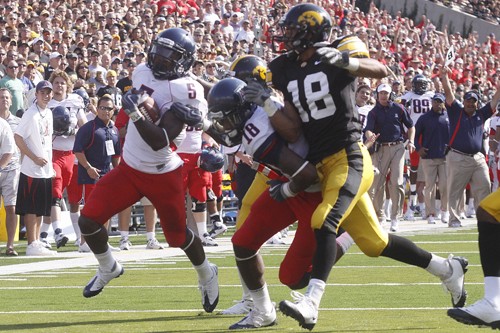The Pacific 10 Conference has a long and storied background of being a prolific passing league. In this decade alone, it has produced NFL quarterbacks like Carson Palmer, Matt Cassel, Matt Leinart, Mark Sanchez, Trent Edwards and Kyle Boller.
In recent years, though, there has been a shift in the balance of power. The offensive fireworks have continued to impress, but most recently on the ground.
And that’s never been more evident than in 2009.
“”It’s always been like that,”” junior running back Nic Grigsby said. “”Everybody’s talked about the passing because of the quarterbacks that have come out of the Pac-10, but we’ve always had great running backs in my time here, no matter how you look at it.””
From top to bottom, the Pac-10’s résumé of runners is impressive this season. Jahvid Best, California’s scoring machine and legitimate Heisman Trophy candidate, leads the pack. But even he has some company.
USC’s boatload of running backs runs six players deep, led by Joe McKnight, C.J. Gable and Stafon Johnson. Oregon thought they were in trouble when potential first-to-second round NFL draft pick LeGarrette Blount was suspended for the season after introducing a Boise State player to his right fist, but backup LaMichael James has stepped in admirably.
Stanford is led by workhorse running back Toby Gerhart, and of course there is the quick and speedy sophomore Jacquizz Rodgers of Oregon State. And finally, Arizona’s Grigsby has proven to be one of the top rushers in all of college football.
It’s quite the exhausting list.
“”I think the reason (for such conference-wide success) is because this is more of a traditional running conference,”” said offensive coordinator Sonny Dykes.
“”I think people don’t realize that people play a lot with two backs and playing with a tight end and the run game is important in this league,”” he added. “”I think right now the backs are productive in the league and the style of play has a lot to do with it.””
What’s surprising about the Pac-10 is that, despite the extraordinary success and the taxing workload, the average running back in the league is very small. Grigsby stands at just 5-foot-10, and Oregon State’s Rodgers is just 5-foot-7.
“”It kind of fits the style of play,”” Dykes suggested. “”The SEC (Southeastern Conference) is typically going to have the bigger backs because it’s more of a power conference and this is a little bit more of a speed conference.””
The speed of these running backs is something that hasn’t been ignored. In the Pac-10 today, running backs are asked to do much more than take handoffs and plow between the tackles. Thanks to their athleticism, running backs get the ball in more inventive ways than ever: traditional handoffs, misdirection plays, sweeps and even through the air.
Grigsby, Arizona’s top play-maker, is no exception.
“”I think we’re trying to find some creative ways to get his hands on the ball and do some different things with him,”” Dykes said. “”We’ve just got to keep trying to find ways to get him the football.””
Grigsby, who head coach Mike Stoops has consistently called the most underrated player in the country, is second in the conference with 133.3 rushing yards per game and leads the conference with a remarkable 8 yards per carry.
The numbers are impressive, but he insists they don’t matter.
“”I’m just going to go out there and perform for my team and be an all-around player, even when I don’t have the ball,”” Grigsby said.
Whether he admits it or not, there is a an underlying competition between Grigsby, Rodgers and Best. The three keep in constant contact, wishing each other luck and exchanging congratulations each week.
Friends? Yes, but with Grigsby and Rodgers going head-to-head in Corvallis, Ore., this weekend, that relationship will be put on hold for a little while.
“”We play each other this week, so we ain’t talking ’til after the game,”” Grigsby said.









